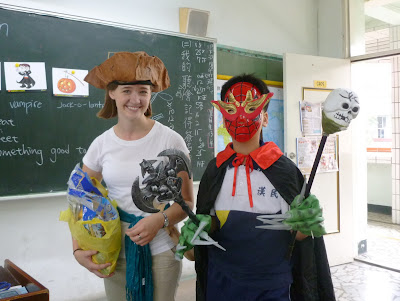Eye patches are cool. And they also suck. Not too long before I "became" a pirate, my online browsing took me to this article (warning: some language), where #5 of their list of 6 Absurd Pirate Myths informed me that pirates did not, in fact, wear eye patches to cover missing eyes, but rather wore them to keep one eye adjusted to the dark when attacking ships, at which point they would need to be able to move quickly--and non-blindly--from the bright light of the deck into the pitch darkness of the cabins, all while swinging a sword and trying not to get killed.
Turns out, this works for haunted houses, too. With kids cycling through a darkened room, letting in streams of light at each end, it helps to work the door with an eye patch on--lower it when the door's open, lift it when it's closed. It actually helped: a lot. Visible difference when I was using the eye-patched eye. So yeah, pirates had a nifty idea for looting ships! And, you know, scaring 5th graders.
The sucky part? More accurate: parts. First off, there's the obvious discomfort--it's just weird to have something covering one of your eyes for an extended period of time; I found myself scrunching up one side of my face trying to keep that eye close for some bizarre subconscious reason. I made mine out of felt, which is pretty good on a skin irritability scale, especially when coupled with the fact that it was held on not with an elastic round-head strap, but a normal headband beneath my hat. But still uncomfortable; a large number of my pictures from teaching this week feature my eye patch folded up on itself and pushed under the brim of my hat to keep it out of the way, and by the end of the day, I was always ready to tear that thing off my head.
 |
| See the thin strap of black on my forehead? Yeah...and this was my FIRST DAY! |
And that's not to mention the inevitable loss of depth perception and peripheral vision. Many missed steps, missed food portions and misshapen letters later (in an unfortunate coincidence, the week I was a pirate brought with it the most board-writing I've had in a lesson plan in quite some time), I've never valued my ability to see what's around me--and know where it is around me--more.
 |
| Not pictured: six other hand-written flashcard words |
If you think your students have gotten used to having a foreign teacher around, donning an eye patch, hat, and sword will turn that assumption right around! It was kind of funny how much attention I suddenly got once I donned my costume. I hadn't realized how used to me students had gotten until I changed the stakes a bit--if a foreign teacher is normal, how about a pirate foreign teacher! Along the same lines, I was surprised at how many kids were actually a little nervous because of my costume--it wasn't anything particularly scary; to my mind, it was actually pretty tame. But an eye patch, watch out! And, on a related note...
Wooden swords work well as attention-getting objects. For some reason, this did not occur to me until I was halfway through the week, but it's fantastic! Teaching vocabulary words on a blackboard has never been more fun than when you can smack it with a wooden sword and ask "What is this?" And kids pay more attention when you're swinging a sword around anyway--highly unusual, and so highly worth paying attention to.
 |
| Yarr, matey! |
And, of course, if they're still not paying attention, a quick rap on the desk (I said desk, not hand, just to be clear) works infinitely better than a ruler to get a student to sit up and listen! I'm only half joking in all of this, of course. :)
I never want to hear "The Legend of Sleepy Hollow" again. Yes, I know, this is not directly related to being a pirate, but in the context of Halloween, it fits perfectly. Over the past week, I have read a simplified version of that story precisely eleven times, line by line, as I waited for my co-teachers to translate into Chinese. The original story is okay, but when you take a kids' version from the Internet and simplify it further for kids who don't speak English, the story becomes unbearable and odd.
Each translation pause opened up a gulf of self-doubting questions about the story: should I have left that detail in? Should I have cut this one out? Why in the world did Washington Irving have a fake ghost in the middle of the story? Should I have read that sentence on its own, or should I have read those two together? And how impactful can a ghost story really be when kids hear each line twice, just in two different languages? Which leads me to...
If you hear the same thing in two different languages enough times, you start to understand bits and pieces of both. This is the one upside of reading "The Legend of Sleepy Hollow" so many times. Among other things, I now have the word "誰" ("who," as in "Wh-who are you," or "你, 你 是 誰?") and the word "南瓜" ("pumpkin"--not hard to think of where that fits in the story), as well as "馬" (horse) and "頭" ("head," as in "he was headless," or "他沒有投"). So yeah, at least Teacher Bekah was learning from the story! Hopefully the kiddos were as well, but it's less likely since they only heard it once.
 |
| 他們的南瓜! / Their pumpkins! |
No comments:
Post a Comment